by Sharon King Hoge
Golden
sunsets, priceless paintings, historic plazas, unique
local cuisine and other national treasures that appeal
to tourists can add substantially to a country's economy.
International tourism receipts added up from around the
globe in 2004 showed a record value of $622 billion US
dollars. For example, the single Pacific Northwest state
of Washington collected $11.6 billion US dollars in direct
travel spending in 2004, a 7.4 percent increase over
the preceeding year. Even destinations such as Turkey
and Austria each reaped $15 billion tourist US dollars.
As a result, countries with flourishing factories and
healthy agriculture are increasingly discovering the
lucrative benefits to be gained from setting up an effective
tourism industry.
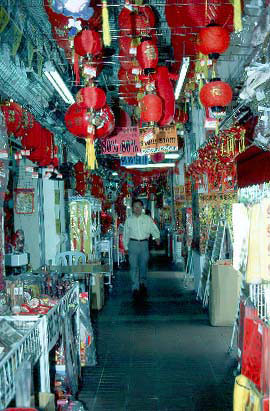 Asia, in particular, is an attractive new destination. In a major development
last year, China took over from Italy as the world's fourth most visited destination.
Recovering from the SARS setbacks, tourism into China showed a spectacular 27
percent increase – due to a record of 42 million tourist arrivals generating
nearly $26 billion US dollars. Additionally, for the first time Hong Kong was
listed among the world's top ten tourism destinations last year.
Asia, in particular, is an attractive new destination. In a major development
last year, China took over from Italy as the world's fourth most visited destination.
Recovering from the SARS setbacks, tourism into China showed a spectacular 27
percent increase – due to a record of 42 million tourist arrivals generating
nearly $26 billion US dollars. Additionally, for the first time Hong Kong was
listed among the world's top ten tourism destinations last year.
Besides infusions of cash from a business that generally possesses higher margins
than manufacturing, tourism fosters economic enterprise. Catering to tourist
needs is an incentive to develop a service sector and creates jobs in regions
of the country where work might be scarce. Entrepreneurial opportunities are
extended to small businesses that spring up to develop tourist attractions, restaurants
and other facilities, market excursions and provide guide services, establish
shopping and retail activity, sell souvenirs and create handicrafts. Tourist
amenities also appeal to employees of established industries, offering attractive
R&R opportunities and resources to complement the lifestyle opportunities
available, and making the region more attractive, to expatriates and other people
employed in the area.
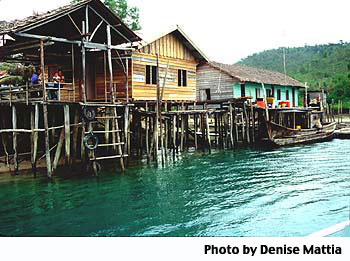 Tourism also provides a number of non-monetary benefits. Since many visitors
are attracted to out-of-the-way areas, the development of these locales promotes
decentralization and alleviates the strain placed on industrial areas of the
country. This helps to achieve a greater balance in utilizing resources. Enhancing
areas with tourist appeal helps preserve vital natural resources that might otherwise
be ignored, underdeveloped or despoiled by industrial enterprise.
Tourism also provides a number of non-monetary benefits. Since many visitors
are attracted to out-of-the-way areas, the development of these locales promotes
decentralization and alleviates the strain placed on industrial areas of the
country. This helps to achieve a greater balance in utilizing resources. Enhancing
areas with tourist appeal helps preserve vital natural resources that might otherwise
be ignored, underdeveloped or despoiled by industrial enterprise.
 Finally, tourism enhances a country's image and reputation, allowing local residents
and visiting foreigners to interact and exchange customs and expectations. After
leaving, travelers disseminate a good impression of the country by sharing memories
and experiences with people back home. This helps to attract additional visitors
and often investments as well.
Finally, tourism enhances a country's image and reputation, allowing local residents
and visiting foreigners to interact and exchange customs and expectations. After
leaving, travelers disseminate a good impression of the country by sharing memories
and experiences with people back home. This helps to attract additional visitors
and often investments as well.
Despite the clear potential, however, few governments are doing an effective
job of building these industries to the maximum extent possible. Even countries
with long-established tourism organizations are apt to lessen their effect by
attempting to develop the tourism industry with occasional intensive promotions
that lack continuity and direction or which the same methods they use to attract
industrial investors.
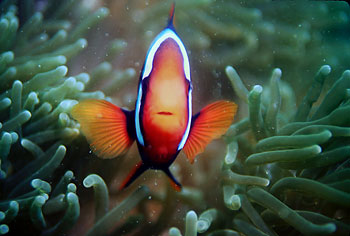 In fact, while there is some overlap, tourism and industrial development are
very different. For one thing tourism promotion is generally more consumer-oriented
and concerned with comfort, enjoyment and other intangibles, even when reaching
out to efficiency-conscious corporate travelers. Industrial promotion, however,
usually allows a more targeted approach, and concerns itself with issues that
are more easily analyzed, such as the effect a particular location will have
on a company’s operations and long-term profitability.
In fact, while there is some overlap, tourism and industrial development are
very different. For one thing tourism promotion is generally more consumer-oriented
and concerned with comfort, enjoyment and other intangibles, even when reaching
out to efficiency-conscious corporate travelers. Industrial promotion, however,
usually allows a more targeted approach, and concerns itself with issues that
are more easily analyzed, such as the effect a particular location will have
on a company’s operations and long-term profitability.
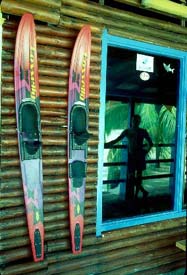 As a result, a different, distinct and focused plan of action is required to
develop a comprehensive strategic and promotion program that will maximize tourism
opportunities. This requires the methodical identification of available opportunities,
the prioritization of target visitors, design and implementation of a promotional
campaign, and finally measurement and evaluation of results achieved.
As a result, a different, distinct and focused plan of action is required to
develop a comprehensive strategic and promotion program that will maximize tourism
opportunities. This requires the methodical identification of available opportunities,
the prioritization of target visitors, design and implementation of a promotional
campaign, and finally measurement and evaluation of results achieved.
There are several key points we encourage clients to keep in mind if they are
to achieve this goal. An essential first step is assessing national resources
that could be attractions and the ability of existing infrastructure to service
the demand that is created. Resorts, spas and regions of scenic beauty appeal
to vacationers and sightseers gravitate to museums, performances, and other cultural
opportunities. Active tourists may be drawn to gambling and night life; convention-goers
have their own requirements for meeting rooms and facilities. The emergence of
eco-tourism is a growing trend. Belize and the Galapagos are two Latin countries
that focus on unique fauna and wildlife, and visits to the Australia's Great
Barrier Reef, Cradle Mountain, and Tasmania now account for nearly 71% of that
country's tourism market. At the same time, the desire to experience untouched,
natural beauty should not be confused with a willingness to sacrifice comfort
and tolerate primitive facilities.
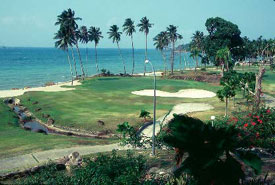 While any tourist is apt to possess a combination of interests, it is most efficient
to match interests to focus on the appropriate audience -- groups, families,
young or old, upscale, local markets or general interest. An effective tourism
program aims its message at the proper potential visitor. Batam, for example
in Indonesia attracts day-trippers from Singapore who are drawn to the island's
six spectacular golf courses less than an hour's ferry ride away. Their success
is now leading to supplemental efforts to attract visitors from further away.
Additionally, experts recently were dismayed to see a major Asian country spending
a large sum to display travel posters in a New York City transport facility where
statistically fewer than half of those passing by hold passports.
While any tourist is apt to possess a combination of interests, it is most efficient
to match interests to focus on the appropriate audience -- groups, families,
young or old, upscale, local markets or general interest. An effective tourism
program aims its message at the proper potential visitor. Batam, for example
in Indonesia attracts day-trippers from Singapore who are drawn to the island's
six spectacular golf courses less than an hour's ferry ride away. Their success
is now leading to supplemental efforts to attract visitors from further away.
Additionally, experts recently were dismayed to see a major Asian country spending
a large sum to display travel posters in a New York City transport facility where
statistically fewer than half of those passing by hold passports.
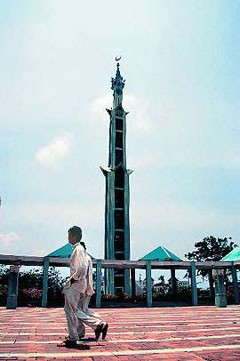 Once destinations and potential visitors have been targeted and a strategy defined,
a promotional campaign must be developed to extend the invitation to visit. Expertise
is required to devise a slogan or identifiable advertising theme, to write and
design brochures and pamphlets, and contact members of the media who will potentially
write about the country's offerings and assets. The now familiar Puerto Rico
theme is credited with raising the island's profile and increasing its tourist
revenues by a substantial amount.
Once destinations and potential visitors have been targeted and a strategy defined,
a promotional campaign must be developed to extend the invitation to visit. Expertise
is required to devise a slogan or identifiable advertising theme, to write and
design brochures and pamphlets, and contact members of the media who will potentially
write about the country's offerings and assets. The now familiar Puerto Rico
theme is credited with raising the island's profile and increasing its tourist
revenues by a substantial amount.
Familiarity with the media is essential to match potential publications and writers
with topics that will interest and appeal to particular journalists, and care
must be taken to differentiate between news and feature columnists who have totally
different assignments and interests. Receptions and dinners can be arranged where
members of the press are entertained, providing a forum to acquaint them with
travel opportunities. Well-executed press events can be extremely effective,
resulting in extensive media coverage across a wide range of publications and
mediums. 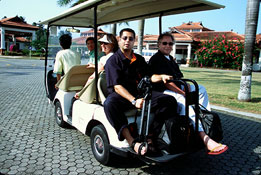 The cost, especially when compared to advertising can be surprisingly
low, especially when care is taken to enlist local airlines, hotels and other
attractions as promotional partners.
The cost, especially when compared to advertising can be surprisingly
low, especially when care is taken to enlist local airlines, hotels and other
attractions as promotional partners.
In many regions, alliances are formed to strengthen the reach of local tourism
efforts. Trinidad and Tobago's TIDCO (Tourism and Industrial Development), for
example, was created in 1993 with the mission "To Market and Promote Brand
T&T." In some regions public officials, hoteliers, and airlines join
forces to share the expenses and responsibilities. For example, according to
Marriott Hotels, a program developed in the Caribbean with local officials and
American Airlines granting three AAadvantage miles for every $1 US dollars spent
locally has significantly increased the profile of travelers, and traffic, to
their resort in St. Kitts and to the island overall.
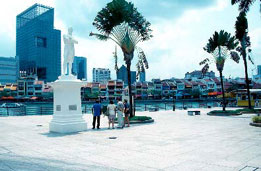 On the local front, tourist facilities need to be monitored by experts who can
determine whether service is up to standards and expectations of visitors. Travelers
who arrive at a resort may be dismayed to find that no transport is available
for sightseeing to the nearby town. Vacationers may object to the sight of cell
phone towers on the premises or restricted hours of food service. Many of these
obstacles are easily resolved with proper attention and support.
On the local front, tourist facilities need to be monitored by experts who can
determine whether service is up to standards and expectations of visitors. Travelers
who arrive at a resort may be dismayed to find that no transport is available
for sightseeing to the nearby town. Vacationers may object to the sight of cell
phone towers on the premises or restricted hours of food service. Many of these
obstacles are easily resolved with proper attention and support.
To monitor, and maximum the results achieved, National Tourism Administrators
are encouraged to establish local representatives in key target markets. This
allows continual ongoing contact with journalists, travel agents, potential visitors
and other targeted entities. It also allows ongoing continuity and promotes maximum
interest in a respective destination. Having a representative office does not
mean, however, only responding to incoming requests or initiating the occasional
media tour. Successful campaigns often entail local meetings and promotions,such
as food tastings, cultural events and other activities designed to build awareness
and a desire to experience the region first hand.
During the first five months of 2005 already, world tourism has already shown
growth of 8%. With proper planning and guidance, tourism can add significantly
to the country or region's economy, and development of an effective tourist industry
can be a matter of national pride and profit.
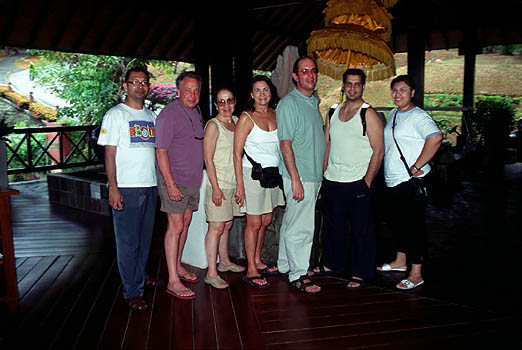
Pictures within this article were taken by Denise
Mattia, a New York-based travel photographer and journalist
during a recent press familiarization
visit organized by KWR International to help promote U.S. and international
tourism traffic to Batam, Indonesia. For info on how KWR can
support your own tourism
development efforts, please contact Keith W. Rabin, President at tel. +1-212-532-3005,
kwrintl@kwrintl.com.




 Asia, in particular, is an attractive new destination. In a major development
last year, China took over from Italy as the world's fourth most visited destination.
Recovering from the SARS setbacks, tourism into China showed a spectacular 27
percent increase – due to a record of 42 million tourist arrivals generating
nearly $26 billion US dollars. Additionally, for the first time Hong Kong was
listed among the world's top ten tourism destinations last year.
Asia, in particular, is an attractive new destination. In a major development
last year, China took over from Italy as the world's fourth most visited destination.
Recovering from the SARS setbacks, tourism into China showed a spectacular 27
percent increase – due to a record of 42 million tourist arrivals generating
nearly $26 billion US dollars. Additionally, for the first time Hong Kong was
listed among the world's top ten tourism destinations last year.  Tourism also provides a number of non-monetary benefits. Since many visitors
are attracted to out-of-the-way areas, the development of these locales promotes
decentralization and alleviates the strain placed on industrial areas of the
country. This helps to achieve a greater balance in utilizing resources. Enhancing
areas with tourist appeal helps preserve vital natural resources that might otherwise
be ignored, underdeveloped or despoiled by industrial enterprise.
Tourism also provides a number of non-monetary benefits. Since many visitors
are attracted to out-of-the-way areas, the development of these locales promotes
decentralization and alleviates the strain placed on industrial areas of the
country. This helps to achieve a greater balance in utilizing resources. Enhancing
areas with tourist appeal helps preserve vital natural resources that might otherwise
be ignored, underdeveloped or despoiled by industrial enterprise.  Finally, tourism enhances a country's image and reputation, allowing local residents
and visiting foreigners to interact and exchange customs and expectations. After
leaving, travelers disseminate a good impression of the country by sharing memories
and experiences with people back home. This helps to attract additional visitors
and often investments as well.
Finally, tourism enhances a country's image and reputation, allowing local residents
and visiting foreigners to interact and exchange customs and expectations. After
leaving, travelers disseminate a good impression of the country by sharing memories
and experiences with people back home. This helps to attract additional visitors
and often investments as well. In fact, while there is some overlap, tourism and industrial development are
very different. For one thing tourism promotion is generally more consumer-oriented
and concerned with comfort, enjoyment and other intangibles, even when reaching
out to efficiency-conscious corporate travelers. Industrial promotion, however,
usually allows a more targeted approach, and concerns itself with issues that
are more easily analyzed, such as the effect a particular location will have
on a company’s operations and long-term profitability.
In fact, while there is some overlap, tourism and industrial development are
very different. For one thing tourism promotion is generally more consumer-oriented
and concerned with comfort, enjoyment and other intangibles, even when reaching
out to efficiency-conscious corporate travelers. Industrial promotion, however,
usually allows a more targeted approach, and concerns itself with issues that
are more easily analyzed, such as the effect a particular location will have
on a company’s operations and long-term profitability. As a result, a different, distinct and focused plan of action is required to
develop a comprehensive strategic and promotion program that will maximize tourism
opportunities. This requires the methodical identification of available opportunities,
the prioritization of target visitors, design and implementation of a promotional
campaign, and finally measurement and evaluation of results achieved.
As a result, a different, distinct and focused plan of action is required to
develop a comprehensive strategic and promotion program that will maximize tourism
opportunities. This requires the methodical identification of available opportunities,
the prioritization of target visitors, design and implementation of a promotional
campaign, and finally measurement and evaluation of results achieved.  While any tourist is apt to possess a combination of interests, it is most efficient
to match interests to focus on the appropriate audience -- groups, families,
young or old, upscale, local markets or general interest. An effective tourism
program aims its message at the proper potential visitor. Batam, for example
in Indonesia attracts day-trippers from Singapore who are drawn to the island's
six spectacular golf courses less than an hour's ferry ride away. Their success
is now leading to supplemental efforts to attract visitors from further away.
Additionally, experts recently were dismayed to see a major Asian country spending
a large sum to display travel posters in a New York City transport facility where
statistically fewer than half of those passing by hold passports.
While any tourist is apt to possess a combination of interests, it is most efficient
to match interests to focus on the appropriate audience -- groups, families,
young or old, upscale, local markets or general interest. An effective tourism
program aims its message at the proper potential visitor. Batam, for example
in Indonesia attracts day-trippers from Singapore who are drawn to the island's
six spectacular golf courses less than an hour's ferry ride away. Their success
is now leading to supplemental efforts to attract visitors from further away.
Additionally, experts recently were dismayed to see a major Asian country spending
a large sum to display travel posters in a New York City transport facility where
statistically fewer than half of those passing by hold passports.  Once destinations and potential visitors have been targeted and a strategy defined,
a promotional campaign must be developed to extend the invitation to visit. Expertise
is required to devise a slogan or identifiable advertising theme, to write and
design brochures and pamphlets, and contact members of the media who will potentially
write about the country's offerings and assets. The now familiar Puerto Rico
theme is credited with raising the island's profile and increasing its tourist
revenues by a substantial amount.
Once destinations and potential visitors have been targeted and a strategy defined,
a promotional campaign must be developed to extend the invitation to visit. Expertise
is required to devise a slogan or identifiable advertising theme, to write and
design brochures and pamphlets, and contact members of the media who will potentially
write about the country's offerings and assets. The now familiar Puerto Rico
theme is credited with raising the island's profile and increasing its tourist
revenues by a substantial amount.  The cost, especially when compared to advertising can be surprisingly
low, especially when care is taken to enlist local airlines, hotels and other
attractions as promotional partners.
The cost, especially when compared to advertising can be surprisingly
low, especially when care is taken to enlist local airlines, hotels and other
attractions as promotional partners. On the local front, tourist facilities need to be monitored by experts who can
determine whether service is up to standards and expectations of visitors. Travelers
who arrive at a resort may be dismayed to find that no transport is available
for sightseeing to the nearby town. Vacationers may object to the sight of cell
phone towers on the premises or restricted hours of food service. Many of these
obstacles are easily resolved with proper attention and support.
On the local front, tourist facilities need to be monitored by experts who can
determine whether service is up to standards and expectations of visitors. Travelers
who arrive at a resort may be dismayed to find that no transport is available
for sightseeing to the nearby town. Vacationers may object to the sight of cell
phone towers on the premises or restricted hours of food service. Many of these
obstacles are easily resolved with proper attention and support.